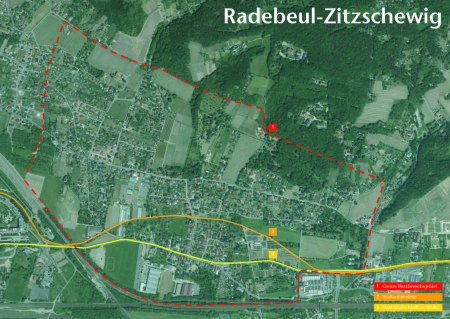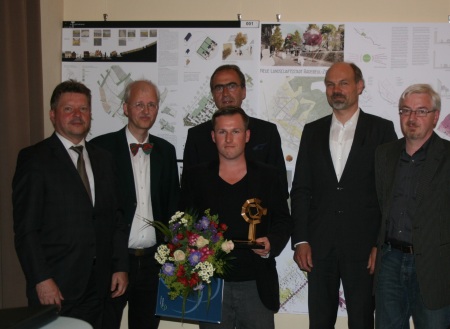Radebeul-Zitzschewig - The village in the city
Competition theme 2013/2014
Building on the first competition, which was very well received and recognised by the specialist public, the current competition once again includes a very interesting and challenging topic to work on. The organiser, together with the expert committee responsible for monitoring the content, has chosen the theme "Radebeul-Zitzschewig! The village in the city". The subject of the competition is the development of an urban development, open space planning and architectural concept for the further development of the Radebeul-Zitzschewig district. Design proposals are to be drawn up on how the slow but steady development of the settlement can be carefully continued against the backdrop of a growing city as a whole, taking into account the characterising historical settlement and open space structures. The competition is intended to encourage an examination of the topic of historic settlement centres in the urban environment and make a contribution to current professional discussion and practice.
Competition area 2013/2014
The district is located on the western outskirts of Radebeul. Zitzschewig was first mentioned in a document in 1366 with the Sorbian place name Czuczkewitz. The core of the settlement is a historic round village and a village extension along the former connecting road between Dresden and Meißen, which today, as a state road, is an important traffic artery in the Elbe valley. Later settlement extensions present themselves as a settlement of different building typologies from different periods of origin that extend to the edges of the vineyards that merge into the highlands. The adjoining landscape is characterised by small farms. The focus is on winegrowing on steep slopes. However, the tourist utilisation of the charming cultural landscape through hiking trails and viewpoints is also becoming increasingly important.

© Stadtverwaltung Radebeul
Expert jury 2013/2014
The expert jury is appointed by the First Mayor as the Councillor for Urban Development and Construction of the City of Radebeul. It consists of 3 members and one representative. In addition, three non-voting judges will be appointed.
Specialist judges
| Alf Furkert | hänel furkert I architekten Dresden, President of the Saxony Chamber of Architects |
| Dr Gabriele Seelemann |
fagus - FachGesellschaft fuer Umweltplanung und Stadtentwicklung mbH, Markkleeberg |
| Prof. Dr Kurt Brey | Architect |
| Olaf Reiter | Reiter Architects Dresden |
Judges
| Katja Leiteritz | association for monument preservation and new building radebeul e.v. |
| Dr Bernd Kastler |
Kastler Winery, Chairman of the Saxony Winegrowers' Association |
| Dr Jörg Müller | First Mayor and Councillor for Urban Development and Construction |
Award ceremony on 27 June 2014

© Stadtverwaltung Radebeul
The Moritz Ziller Prize was awarded in a festive setting on 27 June 2014. After numerous visitors had informed themselves about the 18 competition entries in the exhibition, the actual award ceremony was opened by the saxophone ensemble of the Meißen district music school. First Mayor Dr Jörg Müller introduced the event and moderated the ceremony. Holger Just, Chairman of the Board of Trustees, then informed the audience about the preparations for the competition. The keynote speech was given by Hubert Nienhoff (gmp Architekten von Gerkan, Marg und Partner) on the subject of "Urban development - who is actually building our city?" with exciting projects from China, Spain, Stuttgart, Hamburg and Berlin. The laudatory speech for the prizewinner was given by Alf Furkert, chairman of the jury and chairman of the Saxony Chamber of Architects. The official part of the event ended with the congratulations of the prize winner and the presentation of the prize sculpture by the Mayor of Radebeul, Bert Wendsche.
© Stadtverwaltung Radebeul
Prize winner 2013/2014
Laureate Falko Kubiziel (Dresden University of Technology)

© Falko Kubiziel
The author has developed a concept and presented it clearly in the masterplan, which is based on a detailed analysis of the site and the existing diverse functions. The competition work is preceded by fundamental questions: Does Zitzschewig need more or different open space? Isn't it more important to preserve the green spaces that are so beautifully interwoven with the settlement area than to create structural density? The decision was: It is more important to maintain village structures and qualities and also to preserve agricultural areas as a characterising element of Zitzschewig. The concept therefore aims to bring the structures of viticulture, grassland and pasture farming, historical settlement structures and hiking routes to life. The aim is to emphasise and strengthen existing structures and qualities. This is done in a clear and convincing way by visualising focal points using concise symbols. The main locations recognised as special were the entrances to the town from various directions. Due to its importance for residents and visitors and its central location in the town, the tram stop is given an original design and provides information about the district. Other "special places" at vantage points, path connections, architectural monuments and beautiful scenic features have been assigned functions that enhance the experience and encourage people to stay. There are play elements, seating and orientation aids that help to turn beautiful places into meeting points. Proposals for a better street design are being developed for Meißner Strasse. Several connecting paths are to be given an alley-like character, which is expected to give the landscape a clearer structure and have a speed-reducing effect on road traffic. The conceptual development of the three focal areas Meißner Straße, tram station/Neue Mitte and Aussicht am Zechstein illustrates a sensitive approach to the locations and creates new qualities through minor selective upgrading or additions to existing structures.
Brochure
The brochure for the second Moritz Ziller Prize competition is now available from the city administration. All information about the competition, from the presentation of the competition area to the award ceremony, is contained in this brochure. In the second part, all 18 competition entries are presented in detail by means of a textual description and a number of site plans and images.


